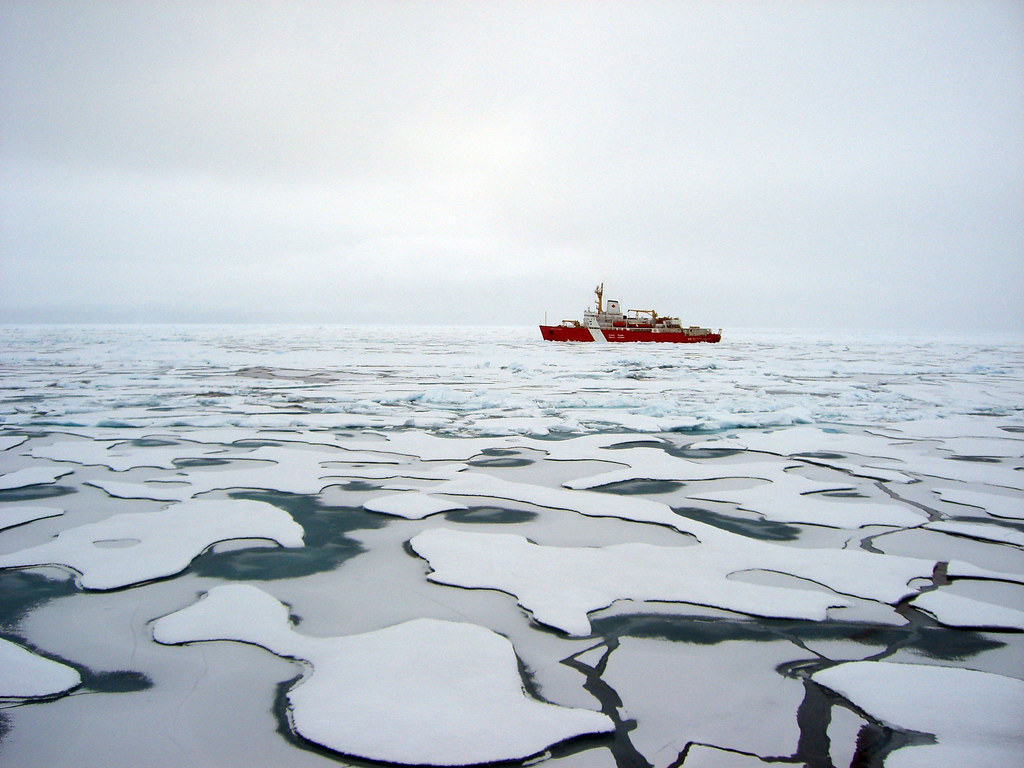Bordering the United States and Russia, between NATO and EU member and non-member countries, the Arctic sub-regions are increasingly the subject of often alarmist, sometimes aggressive rhetoric, focusing on the issues of competition between (major) powers. Between fiction and reality, what are the consequences of this rhetoric for Canada?
We can make three observations. First, the great powers’ games of influence and positioning are limited to two Arctic sub-regions, the Russian Arctic and Greenland, in which the great powers are already well represented, which limits the competitive aspect. Secondly, we need to qualify the practical implementation of this rhetoric. Many of them stir up tension and competition but are not necessarily followed by actual mobilisation because of a lack of resources. Finally, Canada has few options for influencing these power games, although strengthening regional partnerships with its allies could be an interesting avenue for action.
Power Games in Arctic Sub-Regions
Two sub-regions of the Arctic illustrate the competitions between powers: Greenland and the Russian Arctic.
In recent years, Greenland has been at the centre of power and influence games between the United States and China. Its geographical position and its potential for mineral resources, particularly rare earth materials, are assets that give the island a highly strategic position for both the United States and China. These games came into the spotlight in the summer of 2019, when President Trump, in a tweet, indicated the willingness of the United States to buy Greenland (a proposal already made in 1867 and 1946). The strategic interest of the United States in Greenland has materialized in the past with the opening of the Thule air base, located in the north-western part of the island. In recent years, however, China has been trying to gain a foothold in Greenland. In 2018, China Communication Construction Company (CCCC), owned by the Chinese state, won a contract to build airports in Nuuk and Ilulissat. Under pressure from the United States, arguing that there was a risk that these airports would be used for military purposes, these contracts were cancelled at the end of 2019 in the name of security imperatives. Simultaneously with these actions, the United States announced several rapprochements with Greenland: the opening of a permanent consulate in Nuuk in the summer of 2020 and the payment of $12.1 million to support Greenland after the COVID-19 crisis in the natural resources and education sector. In short, the United States is standing in the way of China in Greenland, firmly framing the island in the space and defence of the North Atlantic.
The development of the Russian Arctic is the second Arctic sub-region of interest. Rather than a territory in search of partners, investments, and capabilities, the Russian state possesses impressive military and industrial means, an unmatched icebreaking fleet, and a long-term strategic vision for its territory. The American and Western sanctions imposed on Russia (post-crisis Ukraine) have led the latter to turn to other partners to develop its natural resources. They have thus contributed to the strengthening of the Sino-Russian partnership in the Russian Arctic, which will intensify from 2014, particularly in the projects to develop natural gas, oil and coal resources in the Yamal Peninsula (North-Central), one of the Federation’s most ambitious and strategic projects. A shareholder in the Arctic LNG 1 project via the China National Petroleum Corporation (CNPC) with a 20% stake and the Silk Road Fund with a 9.9% stake, China is developing an “Arctic Silk Road”, which runs through Siberia. The same goes for the 20% participation by CNPC and the China National Offshore Oil Corporation (CNOOC) in the Arctic LNG 2 project. However, two observations must be made to contextualize this Chinese involvement. On the one hand, these two projects have also seen French (the energy group Total) and Japanese (through Mitsubishi, among others) participation. In both cases, these partners invested as much as Chinese investors, making them resolutely multinational initiatives. The Vostok Oil project of the Russian firm Rosneft, for its part, would see the involvement of Indian partners. In both cases these projects, and others in development, remain majority controlled by Russian entities (Rosneft, Novatek), underlining Russian control over these projects. The exploitation of these resources and the strengthening of the Russian military presence (especially in the north-western part of the Federation) are closely linked to Russia’s strategic objective of developing the Northern Sea Route (NMR) as a viable maritime route. The patriotic rhetoric that is conveyed by a certain press in Russia should not make one forget these more pragmatic objectives. With these developments in mind, it is perilous to see a competition between superpowers in the Russian Arctic, since the United States plays a very marginal, if not completely absent, role.
Between rhetoric and actual practice
As a consequence of the aforementioned rhetoric and actions, more striking positions have also been displayed in recent years in the Arctic region. However, they must in the context of the actual capacity of states to implement them.
At the 11th Ministerial Meeting of the Arctic Council in Rovaniemi, Finland, on May 6th 2019, a speech by Mike Pompeo marked a turning point in the Council’s history. He challenged China’s concept of a near-Arctic state, while at the same time challenging China’s real intentions and the development of the Polar Silk Road. He also denounced the modernisation of Russian military infrastructure in the Arctic and questioned the status of the Northeast Passage (NAP) and the Northwest Passage (NWP). This new hard line is also present in the latest documents guiding American military strategy in the zone (USCG Arctic Strategy Outlook of April 2019, Department of Defense Arctic Strategy of June 2019, National Defense Authorization Act 2020 of June 2019, Memorandum on Safeguarding U.S. National Interests in the Arctic and Antarctic Regions of June 2020, Department of the Air Force Arctic Strategy of July 2020). While recalling existing cooperation in the region, these documents identify China and Russia as aggressive and dangerous adversaries in the Arctic.
However, the implementation of this new American line of rhetoric needs to be qualified. Indeed, the United States has a serious capacity deficit, particularly with an icebreaking fleet and port infrastructures reduced to a strict minimum. This discrepancy between rhetoric and actual practice can be illustrated by the statements made in the summer of 2019, underlining the American willingness to conduct Freedom of Navigation Operations (FONOP) in the NAP and NWP. Apart from the security consequences that this would imply, the US Coast Guard (USCG) simply does not have the capacity to conduct these FONOPs. Although the USCG has one heavy icebreaker and one medium icebreaker, neither is available for this type of operation. The Polar Star, a heavy icebreaker, is mobilized to resupply Antarctic research stations for about seven months of the year. The rest of the time it is in dry dock for repairs and refitting. The Healy, a medium icebreaker, is mobilized along the Alaskan coast during the navigable summer months for search and rescue operations and in support of Arctic scientific missions.
In terms of capacity, only two announcements were made by the United States in 2019: a study for the location of future deep-water port(s) in the Arctic (scheduled in the National Defense Authorization Act 2020 in June), and the construction of the first of six heavy icebreakers scheduled in the USCG Arctic Strategy Outlook of April 2019. Most recently, on 9 June 2020, the Trump Administration seemed to take a more concrete position by publishing a “Memorandum on Safeguarding U.S. National Interests in the Arctic and Antarctic Regions”. The Memorandum, which is entirely focused on a programme to acquire an icebreaking fleet for the fiscal year 2029, asks five federal agencies to evaluate, within sixty days, the risks and opportunities of acquiring such a fleet. Despite the title of this memorandum, it should be noted that, to date, this is only another request for a study that does not contain a specific budget – at least until the end of the sixty-day period.
Implications for Canada
For Canada, these power games and rhetoric have potential security implications. On the one hand, in his speech of May 6th, 2019, Mike Pompeo openly claimed freedom of navigation, describing the Canadian position which considers the NWP to be part of its internal waters as illegitimate. On the other hand, it should be noted that the United States depends on the Canadian Coast Guard to clear the way for its ships supplying the Thule base in Greenland and therefore has no interest in seeing an increase in tensions between the two allies. Moreover, despite Pompeo’s declaration and signs from the then U.S. Secretary of the Navy in favour of FONOPs in the Arctic region, these operations have not materialized to date. It is difficult to see how a weakening of the Canada-U.S. relationship and a challenge to Canadian Arctic sovereignty could allow the United States to mitigate Russian and/or Chinese influence in the region. Such action, on the contrary, would be a significant irritant between Canada and the United States, in addition to justifying an increased Chinese presence in the NWP. There is therefore no need to reorient Canadian Arctic policy on this point. In any case, there are few alternatives available to Canada on this issue: the 1989 Arctic Agreement between Canada and the United States still constitutes the bilateral consensus on movement in the NWP, until proven otherwise.
In its future plans, Canada should notably include addressing the issue of modernizing the North Warning System (NWS). The federal government did not allocate funds in its 2020 budget for this modernization. Several voices have been raised in Canada and the United States to warn of the obsolescence of the NWS, which would no longer be able to detect new Russian missiles. General O’Shaugnessy, commander of NORAD, has raised concerns about the aging NWS on several occasions before U.S. Senate committees since 2019. Given the repeated Russian flights near North American space, an effective detection system represents a strategic investment that will take several years to become operational.
In addition, Canada will need to take a position on a possible strengthening of NATO’s presence in the Arctic. The rise of Russian military activism on its northwestern flank has raised fears from Norway, among others. As a result, Canada participated in the NATO military exercise Trident Juncture, held in Norway in the fall of 2018. However, Canada was not supposed to participate in Exercise Cold Response (scheduled for March 2020 and cancelled following the health crisis). Conducted by Norwegian forces, Cold Response exercises bring together the armed forces of many Western partners, NATO members and allies. From the Canadian perspective, the question of what role NATO can play in the region should be posed. At the moment, Exercise Trident Juncture appears to be an exception, a one-time event that the Canadian government has not followed up on. Participation in the annual Cold Response exercises could be an interesting interim solution. Greater synergy between Canadian military exercises in the Arctic and those of Western partners (such as Norway) would help strengthen partnerships with traditional allies.
Recommendations for Canada
The Trump Administration’s strong statements could have an impact on the cooperation and mode of operations of the Arctic Council. Like other international theatres, US Arctic policy now seems to be based on two fundamentals: unilateralism and unpredictability. Although all the Arctic states seem to wish to keep the Arctic as a zone of cooperation and exchange, this new American approach sows doubt. For Canada, the uncertainty surrounding the American position on the NWP is the most significant threat, despite them having taken no action to challenge the 1989 NWP Agreement. The modernization of NORAD and the North Warning System represents an interesting area of collaboration between the two countries. The subject is a matter of consensus and could constitute a strengthening of the Canada-U.S. strategic partnership.
On the other hand, games of influence in the Russian Arctic should not have direct consequences for Canada. NATO’s increased presence in the region, especially in Norway, should be seen as an opportunity for Canada to develop deeper partnerships with allies, liberal democracies moreover. Furthermore, this engagement would strengthen multilateral practices and cohesion among Western countries, which have been undermined by the antagonism of the Trump administration. Canadian participation in military exercises in Norway should be a permanent feature of Canadian Arctic policy. The participation of French, Norwegian, Swedish and Finnish personnel in the Canadian military exercise NANOOK 2019 is an initiative that should be repeated and deepened.
For its part, Greenland is the object of American and Chinese interest, but the potential repercussions for Canada are small: the country does not have the tools or the will to compete with these powers. On the other hand, there is significant potential for Canada to cooperate with Greenland. Indeed, regional cooperation in eastern North America (Nunavut, Nunavik, Labrador and Greenland) is poorly developed. Cross-border co-operation focusing on issues of common and technical interest (fisheries, transportation, economy) could be an interesting and low-risk diplomatic avenue for Canada in its interactions with Greenland. This type of co-operation is certainly not as spectacular as investments by major powers, but could create a ripple effect and foster co-operation in this Arctic sub-region.






Comments are closed.